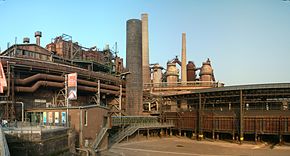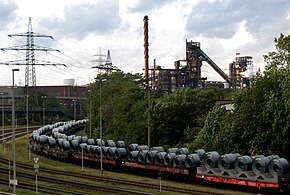Mining industry
Mining industry (from Latin mons 'mountain') is a collective term for the branches of industry that deal with the extraction , processing and direct processing of mineral resources, i.e. mining (especially coal mining ) and raw material processing heavy industry (especially the iron and steel industry ) .
The term was defined by the European Coal and Steel Community (ECSC and " ECSC ") as the predecessor of the European Community and within the industries in this limited Montan co-determination and the European Coal and Steel Co-determination Act .
Iron and Steel Industry
With the industrialization and the invention of the modern blast furnace for raw iron production and the various converter process for steelmaking were artisanal forging and pre-industrial ironworks by steel mills and factories replaced, the products in consistently high quality and low-cost mass production could bring to market.
The term of the coal and steel industry originated for the regionally coherent mining of coal and processing of ores . New technologies have also made products possible that would have been difficult to manufacture manually due to their size, for example railroad tracks and locomotives , which further advanced industrialization, or structural steel , without which the reinforced concrete construction of modern large buildings would not be possible. Without a productive coal and steel industry, there would be no modern vehicle construction .

Steelworks and steel processing factories preferred to settle at locations with access to appropriate raw materials and the possibility of transporting and selling the manufactured products and semi-finished products . Here, hard coal found locally in the steel network was coked and smelted with iron ore and other aggregates and then forged or rolled. In the first industrial nation in the world, Great Britain, the coal and steel industry flourished in the Midlands and north of it, as well as in Wales . Belgium also emerged early with a strong coal and steel industry in Wallonia near Charleroi and Liège . Significant locations in Germany were the Siegerland , the Ruhr area , the Aachener Revier , the Upper Silesian industrial area and Lorraine (up to the World Wars) as well as the Saarland and, to a lesser extent, the Upper Palatinate , Thuringia and the Chemnitz / Erzgebirge area . In the USA the coal and steel industry originated in the area around Pittsburgh , in Spain in the Basque Country for the same reasons . In Sweden a significant mining industry developed in the vicinity of the iron ore deposits, the oldest and for a long time the most important mining area in Russia was the Donets Basin , later the Urals , in France the Nord-Pas-de-Calais region . Classic industrial districts are largely characterized by the settlements around the large-scale industrial plants and the urban centers that emerged later. The dependence on coal and coke production has decreased somewhat with the development of electric steelworks. Later steel districts, such as Koninklijke Hoogovens in IJmuiden in the Netherlands, are not tied to raw material deposits , but are characterized by their proximity to sales centers and shipable goods.
The most important steel producing country is China, followed by Japan and the USA. In Europe, the three most important producers are Russia, Germany and Italy. After the steelworks in Duisburg-Rheinhausen were closed , Duisburg was replaced by Shanghai as the location with the world's most productive blast furnaces.
Mining industry in Germany
While the coal and steel industry in Germany was not only the engine of the German economic miracle until the 1960s , but also an important industrial workplace, the latter's importance has declined sharply since then. The coal and steel crises that have occurred in waves since then have led to a massive increase in productivity in many industrialized countries, concentrated in a few locations and - as a result - to job losses. In the affected areas and cities, this change was accompanied by a profound change in the economic structure . This regional structural change was coped with differently well at different locations or in different countries. In Great Britain, the coal and steel industry, a stronghold of the British trade unions, was literally smashed under the Thatcher government (1979–1990). In Germany, structural change has been significantly cushioned and at the same time slowed down with high hard coal subsidies that have lasted for decades and considerable government support for the regions concerned.
See also
- metallurgy
- Ore Mountains mining region
- Co-determination supplement law (MontanMitbestGErgG)
- Collecting Society for Mining Industry GmbH
- Schuman plan
Individual evidence
- ↑ Definition: coal and steel industry . In: Gabler Wirtschaftslexikon Online . ( gabler.de [accessed on July 25, 2018]).
- ^ Federal Agency for Civic Education: Montanunion | bpb. Retrieved July 25, 2018 .
- ↑ Diercke World Atlas - Map View - Northeast States of the USA - Economy - 978-3-14-100800-5 - 216 - 1 - 1. Retrieved July 25, 2018 .
- ↑ Thomas Urban : The better Spain . In: sueddeutsche.de . November 28, 2016, ISSN 0174-4917 ( sueddeutsche.de [accessed July 25, 2018]).
- ^ Christian Geinitz, Vienna: Donbass: Ukraine needs industry in the separatist area . In: FAZ.NET . ISSN 0174-4909 ( faz.net [accessed July 25, 2018]).
- ↑ Crude steel production by country worldwide 2017 | Statistics. Retrieved July 25, 2018 .
- ↑ Bernd Rexing: November 26, 1987 - closure of the Rheinhausen iron and steel works becomes public . November 26, 2012 ( wdr.de [accessed July 25, 2018]).
- ^ Sine Maier-Bode: Steel: steel crisis . June 26, 2018 ( planet-wissen.de [accessed July 25, 2018]).
- ↑ Federal Government | Off for coal subsidies in 2018. Accessed July 25, 2018 .

